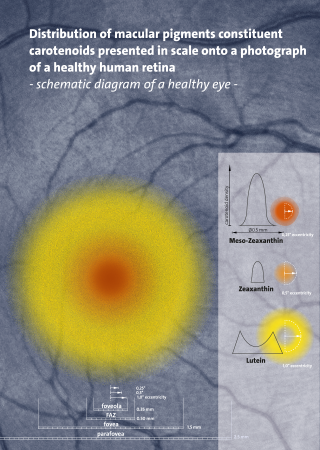
Carotenoids are yellow, orange, and red organic pigments that are produced by plants and algae, as well as several bacteria, archaea, and fungi. Carotenoids give the characteristic color to pumpkins, carrots, parsnips, corn, tomatoes, canaries, flamingos, salmon, lobster, shrimp, and daffodils. Over 1,100 identified carotenoids can be further categorized into two classes – xanthophylls and carotenes.
CRT is the gene cluster responsible for the biosynthesis of carotenoids. Those genes are found in eubacteria, in algae and are cryptic in Streptomyces griseus.
In enzymology, a carotene 7,8-desaturase (EC 1.14.99.30) is an enzyme that catalyzes the chemical reaction

Damascenones are a series of closely related chemical compounds that are components of a variety of essential oils. The damascenones belong to a family of chemicals known as rose ketones, which also includes damascones and ionones. beta-Damascenone is a major contributor to the aroma of roses, despite its very low concentration, and is an important fragrance chemical used in perfumery.
Phytoene synthase is a transferase enzyme involved in the biosynthesis of carotenoids. It catalyzes the conversion of geranylgeranyl pyrophosphate to phytoene. This enzyme catalyses the following chemical reaction
ζ-Carotene (zeta-carotene) is a carotenoid. It is different from α-carotene and β-carotene because it is acyclic. ζ-Carotene is similar in structure to lycopene, but has an additional 4 hydrogen atoms. ζ-carotene can be used as an intermediate in forming β-carotene. A dehydrogenation reaction converts ζ-carotene into lycopene, which then can be transformed into β-carotene through the action of lycopene beta-cyclase. ζ-Carotene is a natural product found in Lonicera japonica and Rhodospirillum rubrum.

15-cis-phytoene desaturases, are enzymes involved in the carotenoid biosynthesis in plants and cyanobacteria. Phytoene desaturases are membrane-bound enzymes localized in plastids and introduce two double bonds into their colorless substrate phytoene by dehydrogenation and isomerize two additional double bonds. This reaction starts a biochemical pathway involving three further enzymes called the poly-cis pathway and leads to the red colored lycopene. The homologous phytoene desaturase found in bacteria and fungi (CrtI) converts phytoene directly to lycopene by an all-trans pathway.
4,4'-Diapophytoene desaturase is an enzyme with systematic name 15-cis-4,4'-diapophytoene:FAD oxidoreductase. This enzyme catalyses the following chemical reaction
All-trans-zeta-carotene desaturase is an enzyme with systematic name all-trans-zeta-carotene:acceptor oxidoreductase. This enzyme catalyses the following chemical reaction
1-Hydroxycarotenoid 3,4-desaturase is an enzyme with systematic name 1-hydroxy-1,2-dihydrolycopene:acceptor oxidoreductase. This enzyme catalyses the following chemical reaction
Phytoene desaturase (neurosporene-forming) is an enzyme with systematic name 15-cis-phytoene:acceptor oxidoreductase (neurosporene-forming). This enzyme catalyses the following chemical reaction
Phytoene desaturase (zeta-carotene-forming) is an enzyme with systematic name 15-cis-phytoene:acceptor oxidoreductase (zeta-carotene-forming). This enzyme catalyses the following chemical reaction
Phytoene desaturase (3,4-didehydrolycopene-forming) is an enzyme with systematic name 15-cis-phytoene:acceptor oxidoreductase (3,4-didehydrolycopene-forming). This enzyme catalyses the following chemical reaction

Phytoene desaturase (lycopene-forming) are enzymes found in archaea, bacteria and fungi that are involved in carotenoid biosynthesis. They catalyze the conversion of colorless 15-cis-phytoene into a bright red lycopene in a biochemical pathway called the poly-trans pathway. The same process in plants and cyanobacteria utilizes four separate enzymes in a poly-cis pathway.
Beta-carotene 3-hydroxylase (EC 1.14.13.129, beta-carotene 3,3'-monooxygenase, CrtZ) is an enzyme with systematic name beta-carotene,NADH:oxygen 3-oxidoreductase . This enzyme catalyses the following chemical reaction
Carotenoid 1,2-hydratase (EC 4.2.1.131, CrtC) is an enzyme with systematic name lycopene hydro-lyase (1-hydroxy-1,2-dihydrolycopene-forming). This enzyme catalyses the following chemical reaction
ζ-Carotene isomerase is an enzyme with systematic name 9,15,9'-tricis-zeta-carotene cis-trans-isomerase. This enzyme catalyses the following chemical reaction
Prolycopene isomerase is an enzyme with systematic name 7,9,7',9'-tetracis-lycopene cis-trans-isomerase. This enzyme catalyses the following chemical reaction
Lycopene β-cyclase is an enzyme with systematic name carotenoid beta-end group lyase (decyclizing). This enzyme catalyses the following chemical reaction
Phytoene desaturase may refer to:




